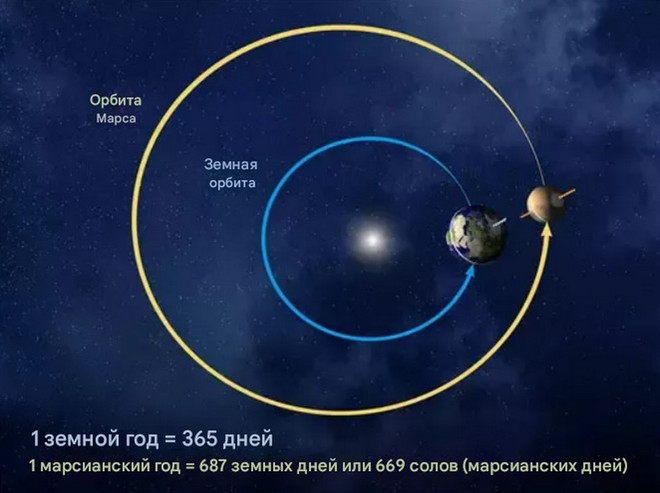Imagine that when astronauts set foot on Mars, it means that the expedition to the Red Planet is only half successful because when astronauts want to return to Earth, leaving Mars is not simple.
The biggest challenge here is to land a massive spacecraft safely on the surface of Mars in the most suitable technical and terrain conditions, so that it can then take off and fly away from Mars.
In fact, scientists now have the ability to build a small unmanned space station that could leave Earth, land gently on Mars, drill for a few samples, and then take off and return to Earth. But a manned spacecraft would be a completely different story.
First of all, to launch a manned spacecraft of sufficient size from Earth into interplanetary space, a giant rocket with a powerful engine is needed.
Basically, the system would have to be the size of a medium-sized tanker, with a lot of fuel in its belly and, of course, some cargo useful to the astronauts.
Mars has about 40% of Earth's gravity and a thin atmosphere, so returning to Earth would require a rocket about one-third the size of the one that took them there.
The rocket needs to be fully fueled to take off and bring astronauts home. So if astronauts want to fly to Mars and return to Earth, they need to carry around 1,400 tons of fuel.
It should be noted that rocket fuel is extremely flammable and explosive, so it needs to be stored in special tanks so that it does not break when the spacecraft lands on Mars.
Mars also has an atmosphere, but unfortunately it is not dense enough for parachutes to function properly. This means that the Martian atmosphere is not suitable for slowing down spacecraft - thanks to the parachute system - so that they can land gently on the Martian surface, ensuring the safety of astronauts and fuel tanks.
Therefore, the spacecraft will have to start the reverse blow engine during landing, and this also consumes a lot of fuel.

It would be much simpler if Mars had no atmosphere at all, because then the landing process could be controlled more precisely.
However, the atmosphere of Mars is very "fickle," meaning that the density of the atmosphere on Mars is always changing, sometimes the atmosphere becomes so thick that it easily slows down the spacecraft (or can even burn it), but sometimes it is so thin that it has almost no effect on the spacecraft's speed.
Faced with that situation, scientists have so far chosen the option of using a reverse thrust engine as the optimal method to make a gentle landing on Mars.
That's why landing a spacecraft, large or small, gently on Mars is still considered a great technical achievement, no matter how many times it's done.
But that's not all. The most complicated thing here is that the distance between Earth and Mars is constantly changing because the two planets orbit the Sun at different speeds.
Earth is closer to the Sun, so it takes only 365.25 days to complete a complete orbit around the Sun. Mars is farther away from the Sun, moves more slowly, and takes 687 Earth days to complete one orbit around the Sun (which is almost twice as long as Earth).
As a result, for most of the year, Mars is quite far from Earth, so far that a flight from Earth to Mars becomes impossible.
The favorable position for an Earth-Mars flight only comes when both planets are on the same side of the Sun, and this only happens once every 778 days (or, in other words, once every 2 years, 1 month, and 18 days).
This once-in-778-day window is the perfect opportunity to make a flight from Earth to Mars, in terms of energy savings and flight time.
Let’s assume that the astronauts successfully made this “timed” flight and made it to Mars. But what happens next? They could only return to Earth after the next close approach between the two planets, meaning they would have to be on Mars for exactly 2 years, 1 month, and 18 days to catch the right moment and fly back to Earth.

The spacecraft will have to take off and fly in the same direction as Mars orbits the Sun, and then the astronauts will have to repeatedly adjust the spacecraft's trajectory to match Earth's orbit and speed around the Sun.
These are quite complex technical operations that astronauts will have to perform in space between planets.
That is also the reason why a "direct flight" taking astronauts to Mars, staying there for a few days and returning to Earth is still an impossible thing - up to now./.
Source: https://www.vietnamplus.vn/vi-sao-cac-nha-du-hanh-vu-tru-van-chua-the-bay-tu-trai-dat-toi-sao-hoa-post1042222.vnp


























![[Photo] National Assembly Chairman attends the seminar "Building and operating an international financial center and recommendations for Vietnam"](https://vphoto.vietnam.vn/thumb/1200x675/vietnam/resource/IMAGE/2025/7/28/76393436936e457db31ec84433289f72)









































































Comment (0)